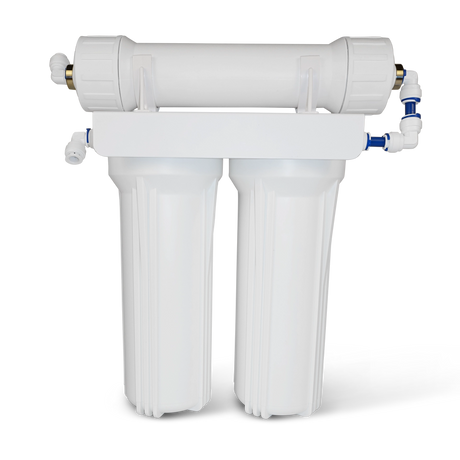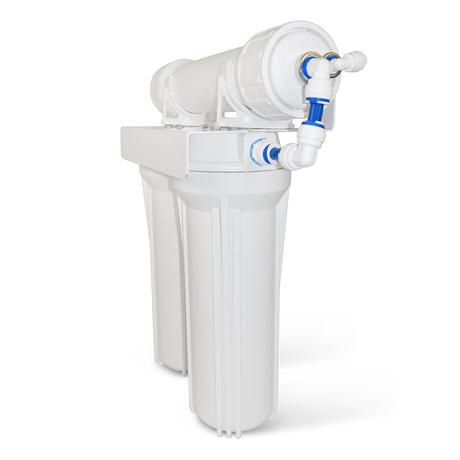Reverse Osmosis Water Waste: How Much Water Is Really Used? [Complete Guide]
![Reverse Osmosis Water Waste: How Much Water Is Really Used? [Complete Guide]](http://premieresales.com/cdn/shop/articles/How-much-water-does-a-reverse-osmosis-system-waste-e1616672207693.webp?v=1725369891&width=1600)
Reverse osmosis (RO) is a widely used method for purifying drinking water in both residential and commercial settings. This advanced filtration process has gained popularity due to its effectiveness in removing a wide range of contaminants. Let's explore the key advantages of RO systems:
- Effective removal of impurities: RO systems can eliminate various contaminants, including dissolved solids, heavy metals, and microorganisms.
- High-quality water production: The result is clean, great-tasting water that's safe for drinking and cooking.
- Easy maintenance: Most modern RO systems require minimal upkeep, making them convenient for homeowners.
- Cost savings: While there's an initial investment, RO systems can save money compared to buying bottled water over time.
However, it's important to consider the potential drawbacks of reverse osmosis:
- Water usage concerns: Some perceive RO systems as wasteful due to the water used during the filtration process.
- Mineral removal: RO filters out beneficial minerals along with contaminants, which some consider a health drawback.
- Energy consumption: Unlike some other filtration methods, RO systems require electricity to operate.
RO Water Waste Debate: Facts vs. Myths
A common question surrounding RO systems is whether they waste water. The answer is nuanced and depends on various factors. Depending on the type, quality, and age of a system, RO units can produce 3 - 25 gallons of waste water per one gallon of purified water.
To understand this better, let's break down the RO process:
- Water enters the system and passes through pre-filters to remove larger particles.
- The water then undergoes cross-flow filtration through a semi-permeable membrane.
- Purified water (called the permeate stream) flows to the storage tank.
- The waste stream (concentrate stream or brine) containing contaminants and dissolved inorganics is directed to the drain.
It's this last step that leads to the perception of water waste. However, it's crucial to understand that this process is necessary for maintaining the efficiency and longevity of the RO membrane.
Reframing the Waste Water Perspective
While the term "waste" is commonly used, it can be misleading. A more accurate description is that reverse osmosis systems use water as part of their purification process. This usage is similar to how we use water for other essential household tasks.
Consider these comparisons:
- Hand washing: All water used goes down the drain, yet it's crucial for hygiene.
- Showering: Uses significant amounts of water, but is essential for personal cleanliness.
- Laundry: Washing machines use large volumes of water, which is necessary for clean clothes.
In each of these cases, we don't typically consider the water as "wasted" because we recognize the benefits of the process. Similarly, the water used in reverse osmosis contributes to the production of clean, safe drinking water.
That said, it's important to acknowledge that some RO systems do use more water than necessary, particularly if they are not properly maintained or are of low quality. This excessive usage can indeed be considered wasteful and highlights the importance of choosing a high-quality system and maintaining it properly.
Water Consumption in RO Systems: Breaking Down the Numbers
The amount of water used by an RO system isn't fixed and can vary based on several factors:
- Water quality: Higher levels of contaminants require more water to flush them away.
- Total Dissolved Solids (TDS): Water with high TDS levels may require more flushing.
- Water temperature: Colder water is more difficult to push through the membrane, potentially increasing water usage.
- Membrane recovery ratio: This indicates how efficiently the system converts feed water to purified water.
- System condition: Older or poorly maintained systems may use more water.
- System size and pressure: Larger systems or those operating at higher pressures may use water differently.
- Membrane type: Different membranes have varying efficiency levels.
As a system ages, it typically uses more water due to the membrane accumulating contaminants over time. Regular maintenance and timely replacement of components can help mitigate this issue.
Membrane Recovery Ratio: Key to RO Efficiency Explained
The membrane recovery ratio is a crucial factor in determining an RO system's efficiency. It indicates how much water is "recovered" as purified RO water compared to the total amount of water that enters the system.
For example, a recovery ratio of 25% means that for every 100 gallons of water that enter the system, 25 gallons are purified, and 75 gallons go to drain. A higher recovery ratio results in less drain water, which is generally more efficient.
However, it's important to note that some RO designs cannot handle high recovery rates as they may lead to membrane scaling and premature fouling. This is why it's crucial to choose a system that balances efficiency with long-term performance.
Most residential RO systems have an actual recovery rate of 10-25%, even if manufacturers claim higher rates. When choosing a system, always ask about the waste water ratio before purchasing. Be wary of claims that seem too good to be true, as they often are.
Zero Waste RO Systems: Revolutionary Solution or Clever Marketing?
In response to water usage concerns, some manufacturers have developed "zero waste" RO systems. But what does this really mean?
"Zero waste" RO systems use the same purification process as traditional systems, but they handle the waste water differently. Instead of sending it down the drain, these systems recycle the waste water within your home. Here's how it typically works:
- The system purifies water as normal, producing both clean water and a waste stream.
- Instead of draining the waste water, it's redirected to other household uses.
- Most commonly, under-sink zero waste RO systems send the reject water to your hot water supply.
While this approach does eliminate water "waste" in the traditional sense, it's important to consider the implications:
- The recycled water contains the contaminants removed from your drinking water.
- You'll be using this water for tasks like washing hands, cooking, and cleaning.
- Depending on your water quality, this could potentially introduce contaminants into these processes.
Therefore, while zero waste systems can be a more water-efficient option, they may not be suitable for all households, particularly those with high levels of certain contaminants in their water supply.
How Reverse Osmosis Works: Demystifying the Purification Process
To truly understand the water usage in RO systems, it's helpful to know how the process works. Reverse osmosis is a water purification process that uses a semi-permeable membrane to remove ions, molecules, and larger particles from drinking water.
Here's a step-by-step breakdown of the process:
- Pre-filtration: Water first passes through a sediment filter to remove larger particles like dust and rust.
- Carbon filtration: Next, it goes through an activated carbon filter to remove chlorine and organic compounds.
- Reverse osmosis: The pre-filtered water is then forced through a semi-permeable membrane under high pressure. The membrane has tiny pores (about 0.0001 micron) that allow water molecules to pass through but block larger molecules like dissolved salts, bacteria, and other impurities.
- Storage: The purified water is stored in a tank until it's needed.
- Post-filtration: When you turn on your RO faucet, the water passes through a final carbon filter to improve taste before reaching your glass.
During this process, the system continuously flushes the membrane to prevent clogging and maintain efficiency. This flushing action is what produces the "waste" water in traditional RO systems.
The result of this thorough process is water that's free from a wide range of contaminants, including:
- Dissolved salts and minerals
- Bacteria and viruses
- Chemical contaminants like lead, arsenic, and fluoride
- Organic compounds
This comprehensive purification is why RO water is often described as "tasteless" - it's free from the minerals and compounds that typically give water its taste.
Expert Tips to Optimize Your RO System's Water Efficiency
To minimize water usage and maximize efficiency, consider these tips when selecting and maintaining your RO system:
- Assess your needs: Determine if you truly need an RO system or if other filtration methods could meet your needs. For example, if your main concern is chlorine taste, a simple carbon filter might suffice.
- Research thoroughly: Before purchasing, investigate different systems' efficiency and recovery rates. Look for independent reviews and certifications.
- Invest in quality: Remember the adage "buy cheap, buy twice." A high-quality system may cost more upfront but can save money and water in the long run.
- Regular maintenance: Replace membranes and filters as recommended by the manufacturer. This keeps your system running efficiently and can significantly reduce water usage.
- Consider water pressure: Ensure your home has adequate water pressure for efficient RO operation. Low pressure can lead to increased water usage.
- Monitor performance: Keep an eye on your water bills and the taste of your water. Sudden changes could indicate maintenance is needed.
By following these guidelines, you can ensure your RO system operates at peak efficiency, minimizing water usage while providing high-quality drinking water.
Reverse Osmosis System for Pure, Safe Drinking Water in 2024
When looking for an efficient RO system, consider options like the HydroGuard HDGT-45 series. This system offers excellent filtration capabilities with fewer filters to replace, making it cost-effective. Key features include:
- Compact design: Fits easily under most sinks.
- Easy installation: Can be set up without professional help in most cases.
- Sanitary quick-change filters: Makes maintenance fast and hygienic.
- Leak detector shut-off valve (FLOWLOK™): Provides peace of mind against potential water damage.
- Water pressure regulator: Protects the system from water hammer and pressure spikes.
This system effectively reduces levels of contaminants like lead, nitrates, cysts (such as cryptosporidium and giardia), arsenic, and sodium, among others.
Ultrafiltration: The Eco-Friendly Alternative to Reverse Osmosis
While reverse osmosis is highly effective, it's not the only option for high-quality water filtration. Ultrafiltration (UF) offers several advantages over traditional RO systems:
- Zero wastewater production: UF systems don't produce a waste stream.
- Low-pressure operation: Works effectively even in low water pressure conditions.
- No energy required: Operates without electricity.
- No storage tank needed: Produces filtered water on demand.
- Retention of beneficial minerals: Unlike RO, UF doesn't remove dissolved minerals from water.
One example of an efficient UF system is the Premiere PS-PURUF. This multi-stage drinking water system features:
- A 0.02 micron ultrafiltration membrane
- Two high-performance 0.5 micron carbon filters
- Over 99.9% bacteria and pathogen removal
- Reduction of heavy metals and chemicals including chlorine, chloramines, pharmaceuticals, pesticides, lead, and VOCs
- On-demand water production (up to 1.5 gallons per minute)
- No storage tank required, reducing the risk of bacterial growth
The PS-PURUF system can be an excellent alternative to traditional RO systems, especially for those concerned about water usage or mineral retention.
Conclusion: Making an Informed Decision
Choosing the right water filtration system for your home involves weighing various factors, including water quality, usage patterns, environmental concerns, and personal preferences. While reverse osmosis systems are highly effective at producing clean, safe drinking water, they do come with considerations regarding water usage and mineral removal.
By understanding how RO systems work, their benefits and drawbacks, and the factors that affect their efficiency, you can make an informed decision about whether an RO system is right for your home. If water usage is a primary concern, consider exploring alternatives like ultrafiltration or high-efficiency RO systems.
Remember, the goal is to find a solution that provides you with safe, great-tasting water while aligning with your values regarding resource conservation. Whether you choose reverse osmosis, ultrafiltration, or another filtration method, regular maintenance and proper use will ensure you get the best performance and longevity from your system.
Ultimately, investing in a quality water filtration system is an investment in your health and wellbeing. Take the time to research and choose wisely, and you'll enjoy the benefits of clean, purified water for years to come.



